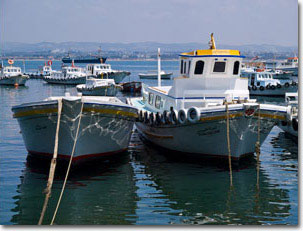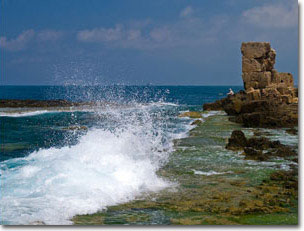|
2.5 km
offshore from Tartous; originally settled a s an urban center by the
Canaanites, it was a prosperous trading center by the late second
millennium. Under the Phoenicians, it became the base for a series of
settlements of the coast as far as Jeble and inland almost to Homs and
to the cult center at Baetocecea (Husn Suleiman), its seafaring skills
gave it an important role in eastern Mediterranean trade in the first
half of the first millennium BC. s an urban center by the
Canaanites, it was a prosperous trading center by the late second
millennium. Under the Phoenicians, it became the base for a series of
settlements of the coast as far as Jeble and inland almost to Homs and
to the cult center at Baetocecea (Husn Suleiman), its seafaring skills
gave it an important role in eastern Mediterranean trade in the first
half of the first millennium BC. After the decline of Ugarit, Arwad has become the principle Phoenician
commercial power on the Syrian coast, rivaling Sidon in the south of
present-day Lebanon. Tiny though it is, Arwad has had an extraordinary history. Any place
that has its origins written up in Genesis must be destined for a role
of some significance. As the sole of habitable island off the Syrian
coast and the only sizeable natural port between Tripoli and the mouth
if the Orontes its inhabitants were able at times to dominate large
areas of the fertile coastal region. It was later taken by the Assyrians and the Achaemenid Persians. St.
Paul is said to have stopped there on his journey to Rome. It was a
Byzantine naval base but fell to the Arabs late 640, holding out after
mainland Syria. The Templars were given custody of the island during
the Crusader presence. From Arwad, the Crusaders made their last sta nd,
hanging in until 1302, many years after the fall of the great mainland
bastions - the Krak 1271, Qalaat Marqab 1285, Tripoli 1289 - and a
decade after the loss of Acre and their last bases in the mainland,
Athlit and Tartous 1291. nd,
hanging in until 1302, many years after the fall of the great mainland
bastions - the Krak 1271, Qalaat Marqab 1285, Tripoli 1289 - and a
decade after the loss of Acre and their last bases in the mainland,
Athlit and Tartous 1291. There are two small castles. The one in the middle of the island represents only part f the 13th century Crusader fort, which is now a museum. The other castle (on the port side) is Arab of Cyprus. |


